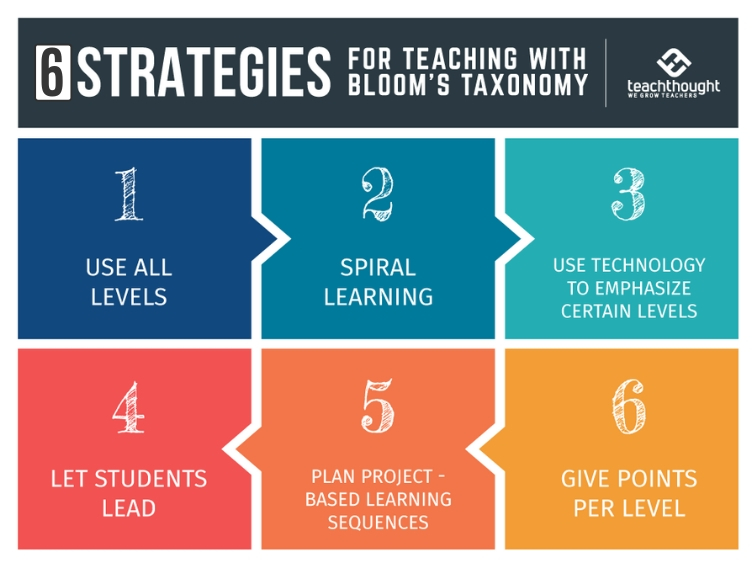
What Are The Best Strategies For Teaching With Bloom’s Taxonomy?
by TeachThought Staff
Bloom’s Taxonomy can be a powerful tool to transform teaching and learning.
By design, it focuses attention away from content and instruction, and instead emphasizes the ‘cognitive events’ in the mind of a child. And this is no small change.
For decades, education reform has been focused on curriculum, assessment, instruction, and more recently standards, and data, with these efforts only bleeding over into how students think briefly, and by chance. This means that the focus of finite teacher and school resources is not on promoting thinking and understanding, but rather on what kinds of things students are going to be thinking about and how they’ll prove they understand them.
Learn more in An Introduction To Bloom’s Taxonomy Course by TeachThought University
This stands in contrast to the characteristics of the early 21st-century, which include persistent connectivity, dynamic media forms, information-rich (digital and non-digital) environments, and an emphasis on visibility for pretty much everything. What does this mean for how you use Bloom’s Taxonomy in your classroom? What kinds of adjustments should you make–if any–in light of these shifts in the 21st-century?
6 Strategies For Teaching With Bloom’s Taxonomy
1. Use Every Level
There is nothing wrong with lower levels of Bloom’s taxonomy.
Memorization is much-maligned as a waste of time that dumbs down student learning, and sure-fire evidence that teachers aren’t doing their jobs. But in reality the broader and more diverse a student’s knowledge background and schema are, the more fluidly they’ll be able to transition across the various levels of Bloom’s.
Memorization can reduce the cognitive load on a student as they process information, allowing for quick recall and application rather than breaking that thinking process apart, first finding information, then evaluating its credibility, and only then moving on to the cognitive main course.
In short, the more ‘immediate access’ a student has to information, the more naturally they can not only apply that information at higher-levels of thinking, but also can initiate these kinds of actions on their own, making their own connections, identifying their own misunderstandings, and more fluidly transferring understanding to new and unfamiliar situations on their own.
2. Use Bloom’s Spiraling
Bloom’s Spiraling is the process of starting first at lower levels of Bloom’s–recalling, defining, explaining, etc.–and then progressively increasing the level of thinking. In that way, Bloom’s Taxonomy becomes a kind of pathway to guide the learning process itself.
First defining a right triangle, then explaining its characteristics, comparing it to other geometric shapes, arguing for or against some right triangle-related idea, then finally designing a novel use of the right triangle in design or architecture, for example. In this process, all students start at the same point–recognizing and defining–and then ‘move up’ Bloom’s Taxonomy, with the ‘Create’ level helpfully providing a flexible ceiling that can stretch to meet the needs of even the most advanced understanding while still acting as a goal for students that might struggle.
And more broadly, Bloom’s Spiraling can be used to frame a lesson, assessment, or even a project-based learning unit.
3. Use Technology To Emphasize Specific Levels
As the highest level of Bloom’s revised taxonomy, ‘Create’ requires students to use innovative–or at least inventive–thinking.
While many classrooms force awkward collaboration on students, even with the best of intentions and skilled use of pre-assessment data, this kind of collaboration can stifle student curiosity and individual talents while placing a premium on socialization, procedural knowledge, and assignment compliance. While this may be ‘real world,’ it could be that there are some parts of that world better left to the life they’ll spend as adults. If we can do better in our design of learning experiences we should, and this means giving every student room to breathe cognitively and creatively.
One approach here is to use digital technology and social media to enable asynchronous collaboration using apps, social media, or digital communities. Here, students can access different strands of a given assignment at their own pace, adding their own thinking, and being able to observe, sit back, internalize, and then offer strategic input according to their own readiness, background knowledge, and relative expertise.
Note that this can be especially effective for teaching introverts, especially creative introverts that may not be able to advocate for themselves in the pressure of a large group at the social dynamics it represents.
4. Let Students Lead
For starters, you can let students bring their ideas to the Bloom’s framework.
Among other effects, this can make cognitively challenging work at the upper levels of Bloom’s seem more accessible. One example? Compare and contrast Shakespeare’s use of thematic development across 3 sonnets, or do the same for two songs by Lupe Fiasco and one sonnet by Shakespeare. If nothing else, BYOM allows students to start any learning experience on somewhat solid ground.
Further, as a classroom this should collectively yield a diverging collection of media, which can be celebrated in classroom showcases, and community-driven and place-based education, with diversity being among the strategies Silver, Strong, and Perini recommend in Teaching What Matters Most (an affiliate link to a book I highly recommend for any educator).
5. Plan Project-Based Learning sequences
Using Bloom’s Taxonomy to plan PBL sequences isn’t as difficult as it sounds. In this case, it simply means that if a student is doing a project on recycling, for example, the ‘sequence’ could begin at lower levels, where the student recalls, defines, and identifies key components of recycling, its challenges, etc. Then, students begin to analyze cause/effect of many of those components and challenges, then evaluates the effectiveness of existing recycling techniques, then finally creates new strategies to increase recycling, improve adoption rates, etc.
6. Give points per level
To encourage students to move from lower levels of Bloom’s to higher levels (and again, lower levels of bloom’s aren’t necessarily ‘bad’ and higher levels aren’t necessarily ‘good’), you can give fewer points for students if they ‘stay too long’ in the lower levels–in a classroom discussion, for example. In this case, you could award the same number of points for lower and higher levels at first, but begin reducing points if students don’t increase the complexity of the discussion, their thinking, their writing, or whatever the assignment might be.
Conclusion
Thinking isn’t any different today than it was a hundred years ago. Only it is. Using Bloom’s Taxonomy in the 21st-century is more complicated than the above strategies honor.
The idea here is to somewhat model how we can adjust the design of learning experiences in response to changes in the world students use information in. Strategically using every level of Bloom’s Taxonomy–even memorization, using asynchronous collaboration, ‘BYOM,’ and Bloom’s spiraling are all steps in that direction.
Using Bloom’s Taxonomy In The 21st Century: 4 Strategies For Teaching; 4 Strategies For Teaching With Bloom’s Taxonomy
